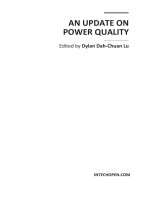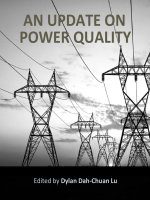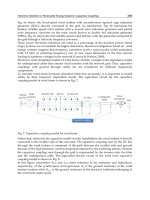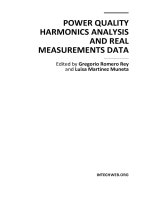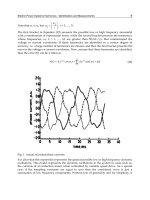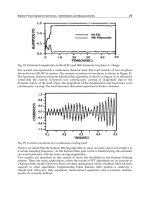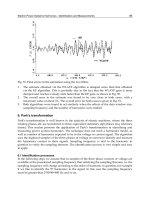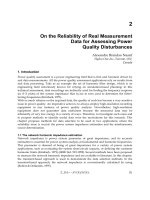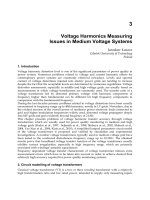7 power quality
Bạn đang xem bản rút gọn của tài liệu. Xem và tải ngay bản đầy đủ của tài liệu tại đây (1.07 MB, 33 trang )
Power Systems & Energy Course:
Power Quality Issues with Large-Scale
Renewable Plants
Jason MacDowell
Power Quality – Renewable Plant Perspective
• Power quality is a two way street!
• Plant effect on grid
• Grid effect on plant
• Interconnection requirements are typically imposed
at the PCC (Point of Common Coupling)
• Impacts at the PCC are a function of:
• Diversity of the individual WTGs/PV arrays
• Characteristics of the collector system
• Characteristics of the transmission grid
© 2016 General Electric International, Inc. All rights reserved. Not for distribution without permission.
11-2
Power Quality Basics
Undervoltages:
Notch – less than one cycle duration
Dip – duration of a few cycles
Sag – duration of seconds to minutes
Interruption – reduction to zero for seconds to minutes
Overvoltages:
Spike – less than one cycle duration
Swell – duration of cycles or more
Waveform Distortion:
Harmonics – steady-state distortion affecting every cycle
integral multiples of operating frequency
Interharmonics – non-integral multiples of operating frequency
Noise – random high-frequency signals
Frequency Shift – variations in frequency through time
Flicker – cyclic or random variations in voltage magnitude
Unbalance – phase asymmetry
© 2016 General Electric International, Inc. All rights reserved. Not for distribution without permission.
11-3
Flicker
Flicker is caused by repetitive variations in voltage – can be
irritant to utility customers
House Pumps
Sump Pumps
Air-Conditioning
Equipment
Domestic
Refrigerators
Oil Burners
Arc Furnace
Flashing Signs
Arc-W elders
Manual Spot-W elders
Sews
Group Elevators
Single Elevator
Heights
Y-delta Changes
on Elevator-MotorGenerator Sets
X-Ray Equipment
Reciprocating
Pumps
Compressors
Automatic
Spot-W elders
5
% Voltage Fluctuation
4
Border Line of
Irritation
3
2
Border Line of
Visibility
1
0
1
2
3
6
10
Fluctuation per Hour
20 30
1
2
4
6
10
Fluctuation per Minute
20 30
60
2
3 4
6
10 15
Function per Second
Measurement of flicker has been standardized by IEC,
using “flickermeter” algorithm (IEC 61000-4-15)
© 2016 General Electric International, Inc. All rights reserved. Not for distribution without permission.
11-4
Flicker in Wind Plant Applications
• Sources of flicker:
–
–
–
–
Wind turbulence, gusting
Drive-train oscillations
Blades passing tower
Induction generator close-in inrush
• Diversity reduces impact on a large wind plant
• DFAG and full-conversion reduces impact
• GE WTG voltage regulation capability virtually
eliminates issue
• For induction generators, dynamic compensation
could be required to meet tight grid specs
© 2016 General Electric International, Inc. All rights reserved. Not for distribution without permission.
11-5
Flicker in Large PV Plants
• Cloud shadow passage potentially can cause significant
voltage variation
– Frequency of variations usually not sufficient to be technically
considered “flicker” unless variations are very large
– Very large voltage variations would be unacceptable for other reasons
• Output of PV plants becomes smoother as plant rating
increases
– Finite size of cumulus clouds that cause the most intermittent
shadowing
– Output of very large plants approaches (1 - %overcast)*Pclear_sky
• Plant level voltage regulation can readily mitigate voltage
variation
© 2016 General Electric International, Inc. All rights reserved. Not for distribution without permission.
11-6
Non-Repetitive Voltage Change
• Some grid codes limit step voltage changes
– Typically 1% - 2% for frequent events
– Some codes relax limits to 3% for infrequent events
• Causes:
–
–
–
–
Capacitor/reactor bank switching
Transformer energization
Feeder switching
Interconnecting HV cable switching
• Solutions:
– Limit size of individually switched banks
(Qmax = DV x MVASC)
– Controlled transformer energization
– Resistor preinsertion
– Point-on-wave switching
– Compensation of HV cables
© 2016 General Electric International, Inc. All rights reserved. Not for distribution without permission.
11-7
Voltage Transients Affecting Grid
• Transients are sub-cycle overvoltages
• In wind plant, usual cause is capacitor switching
– Ringing oscillations, usually at several hundreds of Hz
– Severity depends on point-on-wave of energization
• Solutions
– Synchronized switching -switch closes near voltage zero
– Ideally, eliminates transient
– Experience has been that switchgear must operate often to “keep
in training”
– Impedance preinsertion
– Resistor preinsertion (breakers)
– Lossy inductor (circuit switchers)
© 2016 General Electric International, Inc. All rights reserved. Not for distribution without permission.
11-8
What are Harmonics?
• Non-fundamental-frequency AC currents and
voltages superimposed on the system
– Frequencies are multiples of normal system frequency
– Interharmonics are non-integral multiples
• Results in repeated distortion of the sine wave
• System impacts:
–
–
–
–
Capacitor overload
Excess heating
Device misoperation
Telecommunication interference
© 2016 General Electric International, Inc. All rights reserved. Not for distribution without permission.
11-9
Harmonic Sources in Renewable Plants
• Power converters (used in DFAG, full conversion, and
controlled rotor resistance induction generators)
• PV inverters
• Generators
• Dynamic compensation equipment
– SVCs, STATCOMS
• The grid!
© 2016 General Electric International, Inc. All rights reserved. Not for distribution without permission.
11-10
WTG/Inverter Harmonics
• PV inverters, and power converters used in most WTGs use
PWM technology
– Harmonics are clustered around multiples of the switching
frequency
– High frequency; are easily filtered
– Random phase superposition self-cancels much of the
harmonics produced in a plant with many WTGs/inverters
PWM Waveforms
(Illustration only)
• All rotating machines produce a small amount of harmonics
due to winding configuration
• WTG harmonics do not usually require action in collector
system design
© 2016 General Electric International, Inc. All rights reserved. Not for distribution without permission.
11-11
GE Test Data
Actual values may be less; it is hard to
discriminate harmonics from WTG
from harmonics flowing into WTG
from grid distortion
© 2016 General Electric International, Inc. All rights reserved. Not for distribution without permission.
11-12
Harmonic Performance Specifications
IEEE 519 specifies the following limits for “dispersed generation”:
Harmonic Order
h < 11
12 - 17 18 - 23 23 - 35 35 - 50
Odd
2.0%
1.0%
0.75%
0.3%
0.15%
Even
0.5%
0.25%
0.187%
0.075%
0.037%
THD
THD
2.5%
50
Ih
2
h2
• Voltage specifications might also be made (individual, and RSS)
• Need to consider impact on wind plant equipment as well:
– Transformers
– Capacitors
© 2016 General Electric International, Inc. All rights reserved. Not for distribution without permission.
11-13
Harmonics Injected by Plant Into Grid
“Infinite”
Bus
Iharm
Iharm
Iharm
Iharm
PCC
Zgrid
IPCC
Iharm
Iharm
Iharm
Iharm
Iharm
Iharm
Iharm
Iharm
IPCC not equal to n Iharm
© 2016 General Electric International, Inc. All rights reserved. Not for distribution without permission.
11-14
Impedances at Harmonic Frequencies
Inductive Impedance
Z R jX L R j 2 f L
• Transformers
• Lines and cables
•Shunt reactors
Capacitive Impedance
Z jX C
j
2 f C
• Capacitor banks
• Line and cable charging
• Impedances change with frequency
– Inductive impedance increases with frequency
– Capacitive impedances (negative) decrease in absolute value with
frequency
• Damping (resistive) component can also change in
components affected by eddy current losses
© 2016 General Electric International, Inc. All rights reserved. Not for distribution without permission.
11-15
Resonant Amplification
Igrid
Iinj
Z L ZC
2 f L
V I inj
I inj
2
Z L ZC
j 2 f L C 1
I grid
ZC
1
I inj
I inj
2
Z L ZC
j 2 f L C 1
Harmonic voltage and grid current go to infinity when
(2f) 2-1 = 0
This occurs when f =1/(2 (LC) 1/2)
© 2016 General Electric International, Inc. All rights reserved. Not for distribution without permission.
11-16
Resonant Amplification, with Damping
V I inj
2 f L jR
2 f C R j 2 f L C 1
I grid I inj
2
j
2 f C R j 2 f L C 1
2
• Resonant frequency unchanged
• Magnitude of resonant amplification is reduced
• In a realistic system, harmonic voltages and currents can be
greatly amplified
© 2016 General Electric International, Inc. All rights reserved. Not for distribution without permission.
11-17
Resonance Example
0.15
15
Per-unit
harmonic
voltage
0.1
Current
amplification
factor
10
Vf
If
0.05
0
5
0
200
400
f
600
0
0
200
400
600
f
Typical wind plant parameters, 1% harmonic current injection
from equivalent WTG
Harmonic voltage and current amplification can be great if
resonance coincides with an injected frequency
© 2016 General Electric International, Inc. All rights reserved. Not for distribution without permission.
11-18
The Grid as a Harmonic Source
• Most grids have significant background distortion
– Due to nonlinear loads, P-E devices, transformers
– Greatest at 3rd, 5th, and 7th harmonic
• Good data requires extended-duration monitoring
• IEEE-519 sets “recommended practice” for utilities:
69 – 161 kV
> 161 kV
V THD
1.5% 2.5%
1.0% 1.5%
1.6
1.4
1.2
Voltage (%)
Vh
Measurements made
on an actual utility
system
1
0.8
0.6
0.4
0.2
0
2 3 4 5 6 7 8 9 10 11 12 13 14 15
Harmonic
© 2016 General Electric International, Inc. All rights reserved. Not for distribution without permission.
11-19
Harmonics Injected by Grid Into Plant
PCC
Zgrid
IPCC
VHarm
IWTG
Harmonics from the grid are
a major portion of IPCC
© 2016 General Electric International, Inc. All rights reserved. Not for distribution without permission.
11-20
Resonant Amplification of Grid Harmonics
• Wind plant presents a series resonant circuit
– Substation transformer + capacitor banks & cable
charging
– Can amplify grid distortion
• Problems caused by excess harmonics in collector system
– Capacitor overload
– Component heating (WTG, transformers, cable)
– Misoperation
Vcoll
Vh
Icap
I cap
Vh
Z L ZC
Vcoll Vh
Zc
Z L ZC
A lightly damped resonance can cause severe
voltage distortion on collector, and high currents in
shunt capacitors
© 2016 General Electric International, Inc. All rights reserved. Not for distribution without permission.
11-21
HARMONIC ANALYSIS
© 2016 General Electric International, Inc. All rights reserved. Not for distribution without permission.
11-22
Harmonic Analysis Software Tools
Steady-state phasor analysis – one frequency at a time
• Time-domain modeling tools are not needed
• Some time-domain tools also perform phasor analysis (e.g., EMTP, ATP)
Capability to represent frequency-dependent characteristics of
network components
• XL = 2fL XC =-1/(2fC)
• Long-line characteristics of cables and overhead lines
• Frequency-dependent damping characteristics are extremely important
Must handle a large
number of configurations
© 2016 General Electric International, Inc. All rights reserved. Not for distribution without permission.
11-23
Source Characteristics of WTGs/Inverters
Modern PV inverters and wind turbines do not look like an ideal
harmonic current source
• Internal filters are in shunt
• VSC bridge appears like:
– Ideal current source at low frequency (within controller bandwidth)
– Ideal voltage source at high frequency (f >> controller bandwidth)
– Complex transition of characteristics in between
• Shunt impedance of machine
Norton equivalent is the preferred representation
• Source magnitude spectrum depends on operating point
• Equivalent shunt source impedance is a complex function of frequency –
does not conform to simple models
Characteristics best determined by detailed time-domain
simulation with controls modeled
© 2016 General Electric International, Inc. All rights reserved. Not for distribution without permission.
11-24
WTG representation (Internal Distortion)
• Doubly-fed asynchronous generator machine
• Low distortion energy:
– Converter operated with high switching frequency
– Converter rating is a fraction of turbine rating
• Small distortion filter within the turbine to absorb most of the
distortion energy created by the converter.
Conceptual converter harmonic current distortion flows
© 2016 General Electric International, Inc. All rights reserved. Not for distribution without permission.
11-25
